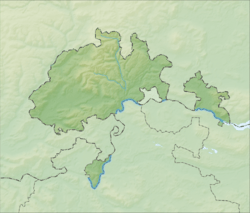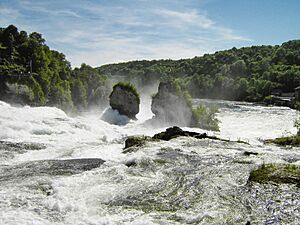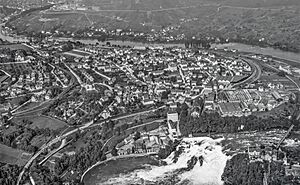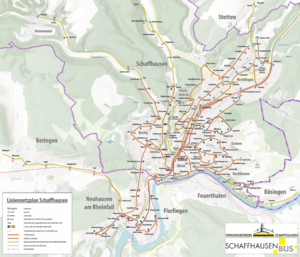Neuhausen am Rheinfall facts for kids
Quick facts for kids
Neuhausen am Rheinfall
|
||
|---|---|---|
 |
||
|
||
| Country | Switzerland | |
| Canton | Schaffhausen | |
| District | n.a. | |
| Area | ||
| • Total | 8.0 km2 (3.1 sq mi) | |
| Elevation | 410 m (1,350 ft) | |
| Population
(Dec 2020 )
|
||
| • Total | 10,467 | |
| • Density | 1,308/km2 (3,389/sq mi) | |
| Postal code |
8212
|
|
| Surrounded by | Beringen, Flurlingen (ZH), Guntmadingen, Jestetten (DE-BW), Laufen-Uhwiesen (ZH), Schaffhausen | |
Neuhausen am Rheinfall is a town and a municipality in the canton of Schaffhausen, Switzerland. It was called Neuhausen until 1938.
This town is famous for being very close to the Rhine Falls. These falls are the largest waterfalls in mainland Europe!
Contents
History of Neuhausen
Neuhausen am Rheinfall was first mentioned in old writings around the years 900 or 910. Back then, it was called Niuhusen. Later, in 1253, its name was written as Niuwenhusin.
Understanding the Coat of Arms
A coat of arms is like a special symbol or logo for a town or family. It often tells a story about its history.
Neuhausen's coat of arms today shows a green cloverleaf and a silver billhook (a type of knife) on a yellow background.
Changes to the Coat of Arms
In 1569, Neuhausen used a different symbol. It had a silver salmon fish jumping on a gold background. This showed how important fishing was to the town long ago.
Later, the colors changed, and the background became red. As fishing became less important, this old symbol was forgotten.
In 1822, a new coat of arms appeared with the cloverleaf and billhook. These symbols were quite common and didn't have a special meaning for Neuhausen.
In 1949, people wanted to bring back the old salmon symbol because it was unique. However, a public vote (a referendum) decided to keep the more modern cloverleaf and billhook design.
Geography of Neuhausen
Neuhausen am Rheinfall covers an area of about 8.1 square kilometers (3.1 square miles).
About 14.5% of this land is used for farming. Forests cover more than half of the area, at 51.3%. Buildings and roads make up 30.9% of the land. The rest (3.2%) is made up of rivers or lakes.
The town is located in the Schaffhausen district. It used to be a small, unplanned village near the Rhine Falls. Today, it is an industrial town with many factories. It is on the southwest side of the city of Schaffhausen.
Neuhausen shares borders with several other towns. These include Laufen-Uhwiesen, Flurlingen, Feuerthalen, Schaffhausen, Beringen, Guntmadingen, and the German town Jestetten.
People of Neuhausen
In 2008, Neuhausen am Rheinfall had a population of 10,080 people. About 35.1% of these people were from other countries.
Many of the foreign residents came from Germany, Italy, Croatia, Serbia, Macedonia, and Turkey.
Over the last 10 years, the number of people living in Neuhausen has gone down a little. Most people (81.2%) speak German. Italian and Serbo-Croatian are the next most common languages.
Age Groups and Education
In 2008, about 17.4% of the population were children and teenagers (0–19 years old). Adults (20–64 years old) made up 59.8% of the population. Seniors (over 64 years old) were 22.7%.
Many adults in Neuhausen have finished higher education. This means they went to a university or a special college.
In 2000, about 27.3% of the people were Catholic. About 37.8% belonged to the Swiss Reformed Church.
Population Over Time
Here's how the population of Neuhausen has changed through history:
| year | population |
|---|---|
| 1524 | 12 houses |
| around 1800 | 206 |
| 1850 | 922 |
| 1888 | 2,023 |
| 1900 | 3,905 |
| 1950 | 7,969 |
| 1970 | 12,103 |
| 2000 | 9,959 |
Economy and Jobs
Neuhausen am Rheinfall has a low unemployment rate, which means most people who want jobs can find them.
In 2005, a small number of people worked in farming (primary sector). Many more worked in manufacturing (secondary sector), like in factories. The largest number of people worked in services (tertiary sector), such as shops, offices, and hotels.
Many people who live in Neuhausen also work there. However, many residents travel outside the town for work. Also, many people come into Neuhausen from other places to work.
The town has 26 restaurants and 3 hotels. These places employ 185 people.
Main Companies
Neuhausen is home to several important companies:
- AGM AGMüller: This company makes playing cards.
- IVF Hartmann AG: This factory produces cotton wool and other medical supplies.
- Schweizerische Industrie Gesellschaft (SIG): This company makes packaging.
- Alcan-Group: This company used to be called Alusuisse and is involved in aluminum production.
Getting Around Neuhausen (Transport)
Neuhausen am Rheinfall has good public transport. You can travel by train or bus.
Train Stations
Neuhausen has three train stations. They are served by local S-Bahn trains, which are like commuter trains. Longer distance trains usually stop at the main Schaffhausen station.
- Neuhausen Station: This station is in the east of town, near the River Rhine.
- It has hourly trains to places like Uster, Schaffhausen, Brugg AG, Winterthur, and Zug.
- Neuhausen Rheinfall Station: This station is right on the northern bank of the Rhine Falls.
- It also has hourly trains connecting to Uster, Schaffhausen, and Jestetten.
- Neuhausen Badischer Bahnhof: This station is in the upper part of the town.
- It has trains every half hour between Erzingen (Baden) and Schaffhausen.
Bus Services
Neuhausen shares a bus network with the nearby town of Schaffhausen. Buses run very often, usually every 10 to 20 minutes. They are run by Verkehrsbetriebe Schaffhausen (vbsh).
Here are some of the main bus lines that go through Neuhausen:
| Line | Route |
|---|---|
| 1 | Herbstäcker – Gemeindewiesen/Durstgraben – Rhenania – Neue Welt – Kreuzstrasse – Rhytech – Neuhausen Zentrum – Gemeindehaus – Bahnhofstrasse – Burgunwiese – Scheidegg – Kreuz – Bahnhof SH – Ebnat – Waldfriedhof |
| 7 | Neuhausen SBB – Rheinstrasse – Industrieplatz – Neuhausen Zentrum – Rhytech – Kreuzstrasse – Fernblick – Zuba – Hohfluh – Trubegüetli – Schützenhaus – Bahnhof SH |
Line 1 uses trolleybuses, which are electric buses that get power from overhead wires. Line 7 uses regular diesel or battery-powered buses.
There is also a regional bus route (line 21) that passes through Neuhausen am Rheinfall. It runs every half hour.
| Line | Route |
|---|---|
| 21 | Bahnhof SH – Kreuz – Scheidegg – Rheinhof – Kreuzstrasse – Engestrasse – Beringen – Löhningen – Siblingen – Schleitheim – Beggingen |
Important Buildings and History
Wörth Castle
Wörth Castle is on a small island in the Rhine River, right near the Rhine Falls. Its name, "Wörth," means "river island."
This castle was first mentioned in the 1200s. For a long time, it was an important stop for traders moving goods between Lake Constance and Basel. This trade route was interrupted by the big Rhine Falls.
When railways were built, water transport became less important. So, in 1835-1836, the building was turned into a restaurant.
Villa Charlottenfels
The Villa Charlottenfels is a very important historical building in Switzerland. It was built between 1850 and 1854. It looks like a castle from the Renaissance period.
It was first built to be a factory. It has large terraces with covered walkways and small buildings called pavilions. One of the pavilions has a large painting by Hans Bendel that shows Swiss history.
Famous People from Neuhausen
- Arthur Rich (1910-1992): A theologian who studied social and business ethics.
- Willy Bührer (1912–1990): A Swiss athlete who competed in the decathlon at the 1936 Summer Olympics. He lived in Neuhausen.
- Dölf Wild (born 1954): A Swiss historian and archaeologist. He is the chief archaeologist of Zürich.
- Thomas Minder (born 1960): A Swiss businessman and politician. He grew up and still lives in Neuhausen.
See also
 In Spanish: Neuhausen am Rheinfall para niños
In Spanish: Neuhausen am Rheinfall para niños









